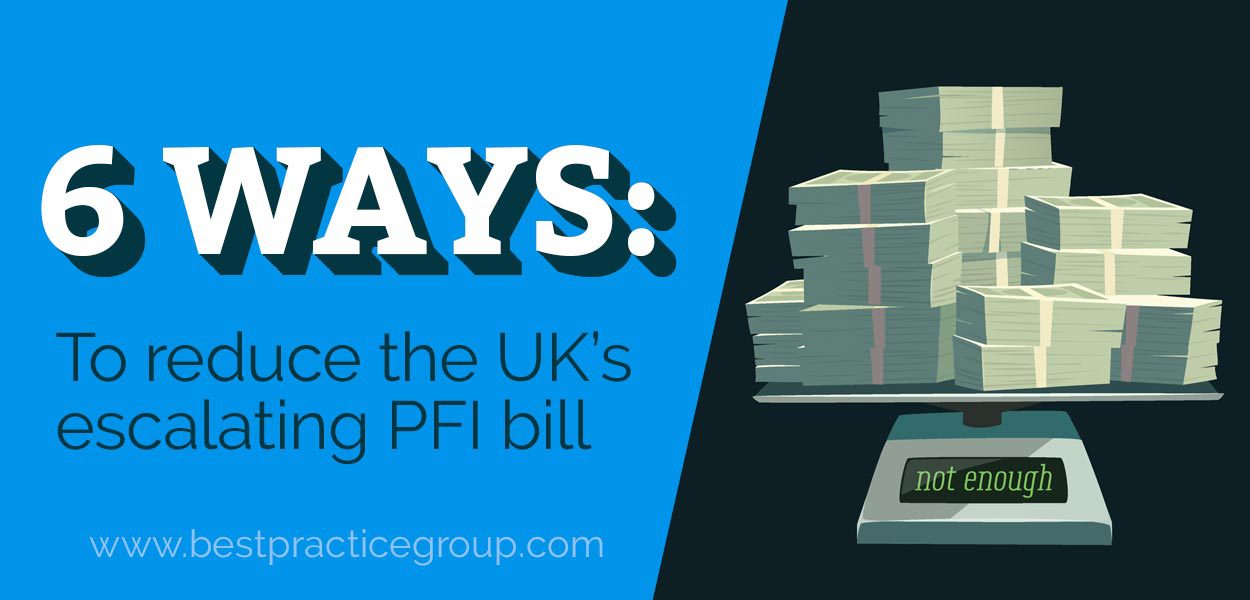
‘PFI deals will cost taxpayers £209bn over next 35 years’, ‘One in five PFI assets will remain in private, rather than public ownership even after the contracts have ended’, ‘Every adult in Britain faces a debt of £4,119 to pay for schools, hospitals, and other infrastructure paid for by controversial financing deals’. These are stark headlines, but with a reported 0.5% of Britain’s GDP going to pay for PFI charges at a time when the government can least afford this it’s not surprising that many senior public sector professionals are looking for ways to reduce the UK’s escalating PFI Bill.
Reports suggest that annual PFI charges are now over £10bn. This ‘build now pay later’ deal structure certainly had its benefits when the government entered into agreements with private sector organisations to build schools and hospitals, roads and systems and then maintain them over the next 20 or 30 years, but public opinion has certainly changed its perspective in times. With a reported 5x mark-up on the cost of building those assets in the first place, complaints about payments continuing sometimes after the institutions had closed down, and increasing strain on austerity led budgets, if a way could be found to reduce this burden there would be many who would be grateful.
According to a recent article in The Independent, Frances O’Grady, General Secretary of the TUC said: “With the cost of government borrowing at an all-time low, it makes no sense to continue with these disastrous contracts. PFIs are quite simply the worst mortgages in the world.”
While others may also share this opinion, the government is contractually obliged to see these agreements through, so to help, we offer our insights into how to best minimise PFI costs.
1. Four important PFI financial monitoring considerations
- Meetings. Do not restrict your PFI meetings to a few senior members of management – involve all key stakeholders when they are needed for input. Their insights can save you time and money, and their involvement can build bridges and win trust for better collaboration and advocacy.
- Tracking. Where does the project stand today, where is it going, what milestone is next to be achieved? Vital information that must be maintained for accuracy. Divide the information contained within your primary financial system into separate spreadsheets to minimise the impact should any one of them be corrupted – either by accident or by malicious attack.
- Calendar. Knowing what costs or savings are due and when is fundamental to effective PFI contract management. And as one of the most complex tasks on the project its importance should not be underestimated – time-sensitive tasks must be scheduled and ticked off, opportunities for adding value taken, and payments must be made on time.
- Formulas. Only by effectively monitoring through meetings, tracking and calendars can you hope to appreciate what needs to be paid, why and when on your PFI contract. The formulas for working out payments are often complex, but they must be mastered and an efficient payment process devised and implemented to avoid late payment penalties.
PFI contract management requires quite a different set of skills to the average public sector project. The sheer scale and complexity of these relationships requires closer collaboration between finance and operational sides, or costs could become difficult to control. Monitoring is a key responsibility, and the following four bullets identify the primary considerations of any PFI financial monitoring strategy:
2. Skilful policing of service availability and performance
Are you getting what you’re paying for? Monthly payments on a PFI contract often include the ongoing maintenance of the asset – hospital, school, etc. But what happens when a wing of your asset becomes unusable when the central heating goes out in the wintertime? The answer is that you should reduce the amount payable for that month to reflect the unavailability of that portion of the asset. The skilful use of availability and performance deductions could save you a considerable sum over time. And it’s important to consider the complex calculation required to determine what proportion of payments to withhold when repair delays mean a partial lack of service or access.
Policing of an asset’s availability and performance must be an ongoing activity as it is important to capture each incident, to monitor its severity and impact, and to record information to create an audit trail in case deductions are disputed at a later date.
The by-product of well-policed availability and performance deductions is the creation of the right environment for an efficient working relationship, one in which it is recognised that poor performance is not acceptable and that, where necessary, penalties may be used to encourage the right behaviours.
3. Contract variations – show me the proof
Throughout your decades-long PFI agreement there are likely to be times when you will wish to make alterations to your agreement – to reduce costs, minimise risks, lessen maintenance requirements, adapt to changing end-user needs or to add value to a project. There may well be costs associated with such a change, but it is a good PFI manager’s role to verify the validity of any development, administrative or legal fee costs. Some of these will be dictated by your agreement, others will be down to your contractor’s diligence, honesty and efficiency. Keep a tight hold on these as the cost of change can be significant and you are likely to need to request this more than once throughout the life cycle of your PFI contract. Where these costs are incurred, be sure to benchmark them against those offered by other providers to ensure you’re getting value for money. If not, challenge the provider on their costs.
4. PFI financing – follow the money
Who owes what to whom? If you can understand the motivations of your contractor you can better negotiate with them. If you know where the finance for the project came from in the first place, and what proportion is owed to which institution, as well as their expectations of repayment, you can use these valuable insights to your advantage.
Twice in your PFI contract’s 20 to 30 year life cycle your contractors will be allowed to take advantage of interest rate changes by refinancing. When this happens you will be entitled to your cut of the savings, so make sure that you are aware of when this is due to happen, and, if your contractor is being ambiguous, ensure that you request an update at regular intervals until clarity is achieved.
5. Take charge of the benchmarking and market testing process
Even though benchmarking and market testing is included within PFI agreements to protect the client, to assess whether prices agreed at the outset remain reasonable in the wider world, they can also be an opportunity for a less scrupulous contractor to ramp up prices and fees. Make sure that you understand the true nature of benchmarking and the shared contractual obligations of this process before diving into it.
If you have chosen to work with a single outsourced partner there may be some services that they are excellent at providing or products they supply at an excellent price and quality, while there could be other services and products that fall outside of their core expertise which may be more expensive when compared to the rest of the market. It is these weaker areas that should be concentrated on when benchmarking and market testing. A more focused assessment will provide a greater amount of evidence to be used in a renegotiation to keep costs down.
6. Operational savings are possible
One of the most widely held myths about PFI contracts is that they are fixed, that once entered into you must suffer them for the life of the agreement without change. This is not the case as there are many situations in which adaptation is possible, if not required.
Clients often review their PFI contracts to reduce their ongoing costs where more cost-effective practices arise in the market or when technology improvements offer efficiency benefits. There may also be occasions when thorough and regular analysis of your PFI contract will highlight current inefficiencies or issues that have crept in through change of use, where the level of the service offered has become out of step with the needs of the end user – for instance a school that once was open six days a week no longer offers Saturday classes, meaning lower costs for heating and lighting, etc.
These are valid reasons for meeting with your contractor to renegotiate your service levels and costs, so long as you are able to evidence your findings.
Conclusion
PFI contracts are often unwieldy, lengthy and costly by their very nature, and to guide all parties on a mutually acceptable and fair path a PFI contract manager must be talented in a broad spectrum of analysis, finance, relationship management and negotiation skills, to name but a few.
The process of keeping costs down on a PFI contract is complex and time-consuming, but with the right approach, a lot of evidence gathering and a strong argument on your side coupled with an understanding of your contractor’s financial motivations and aspirations on the project, and some gifted negotiation skills and a strong understanding of your contract, it is possible to bend your PFI agreement to changing budgetary demands.

